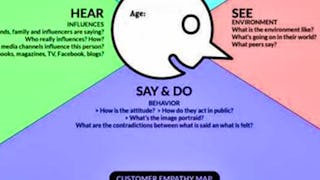Risk Management and Innovation develops your ability to conduct empathy-driven and data-driven analysis in the domain of risk management. This course introduces empathy as a professional competency. It explains the psychological processes that inhibit empathy-building and the processes that determine how organizational stakeholders respond to risk. The course guides you through techniques to gather risk information by understanding a stakeholder’s thoughts, feelings, and goals. These techniques include interviewing, brainstorming, and empathy mapping. The course concludes by using this risk information to enrich data analysis. You will learn basic data visualization concepts in Tableau and use these concepts to explore and explain data. Throughout these analyses, the course challenges you to identify risks by focusing on unmet stakeholder needs.

Enjoy unlimited growth with a year of Coursera Plus for $199 (regularly $399). Save now.

What you'll learn
Use empathy-building tools to identify stakeholder needs and extract risk information
Explain the psychological processes that influence how people respond to risks
Visually explore data using Tableau to identify and explain trends that are relevant to stakeholders
Explain risk as a cause and effect relationship that affects a stakeholder’s goals, thoughts, feelings, or actions
Skills you'll gain
- User Research
- Stakeholder Analysis
- Risk Management
- Data-Driven Decision-Making
- Data Analysis
- Behavioral Economics
- Risk Analysis
- Empathy & Emotional Intelligence
- Risk Control
- Decision Making
- Tableau Software
- Data Visualization
- Psychology
- Data Visualization Software
- Empathy
- Business Risk Management
- Human Centered Design
Details to know

Add to your LinkedIn profile
11 assignments
See how employees at top companies are mastering in-demand skills

There are 4 modules in this course
This course develops your ability to conduct empathy-driven and data-driven analysis in the domain of risk management. Throughout these analyses, the course challenges you to identify risks by focusing on unmet stakeholder needs. In Module 1, you will be exploring the concept of risk and how it can affect decisions. In addition, you will explore some of the psychological biases that affect how people evaluate risk, as well as how emotions influence responses to risk. Finally, the module introduces different categories that organizations use to identify, categorize, and manage risks.
What's included
4 videos9 readings3 assignments1 discussion prompt1 plugin
Module 2 explores the link between risk and empathy. This module discusses the psychology of making decisions for others, and how lack of insight into others can lead you to make different decisions for others than you do for yourself. We will focus on variables such as risk, information volume, and errors of commission and omission.
What's included
3 videos2 readings3 assignments
You will begin applying the ideas of empathy, risk, and self-other decision making to data analysis. You will explore simple ways to gain insight into others’ beliefs and preferences, and ways in which you can present risk information to others in a manner they can understand. The module concludes with contrasts between empathy-driven and data-driven analysis, and some basic tools to link empathy-building to data analysis and some basic principles of data visualization.
What's included
5 videos2 readings3 assignments1 peer review
You will learn how to combine principles of empathy, risk, and data with a focus on approaching problems using analytics and empathy. The module discusses these issues in real-world contexts, with examples drawn from business and from issues of systemic bias.
What's included
4 videos4 readings2 assignments
Build toward a degree
This course is part of the following degree program(s) offered by University of Illinois Urbana-Champaign. If you are admitted and enroll, your completed coursework may count toward your degree learning and your progress can transfer with you.¹
Instructor

Offered by
Explore more from Business Strategy
 Status: Preview
Status: PreviewUniversity of Illinois Urbana-Champaign
 Status: Free Trial
Status: Free TrialThe University of Notre Dame
 Status: Free Trial
Status: Free TrialLearnKartS
Why people choose Coursera for their career





Open new doors with Coursera Plus
Unlimited access to 10,000+ world-class courses, hands-on projects, and job-ready certificate programs - all included in your subscription
Advance your career with an online degree
Earn a degree from world-class universities - 100% online
Join over 3,400 global companies that choose Coursera for Business
Upskill your employees to excel in the digital economy
Frequently asked questions
Once you enroll for a Certificate, you’ll have access to all videos, quizzes, and programming assignments (if applicable). If you choose to explore the course without purchasing, you may not be able to access certain assignments.
You will be eligible for a full refund until 2 weeks after your payment date. You cannot receive a refund once you’ve earned a Course Certificate, even if you complete the course within the 2-week refund period. View our full refund policy.
Yes! Coursera provides financial aid to learners who would like to complete a course but cannot afford the course fee. To apply for aid, select "Learn more and apply" in the Financial Aid section below the "Enroll" button. You'll be prompted to complete a simple application; no other paperwork is required.
More questions
Financial aid available,


